- Influence of quartz in self-compaction concrete at elevated temperature
V. Thamilpriyaa,* and G. Elangovanb
aTeaching Fellow,Department of Civil Engineering, University College of Engineering, Pattukkottai, Tamil Nadu, 614701, India
bAssociate Professor, Department of Civil Engineering, University College of Engineering, Pattukkottai, Tamil Nadu, 614701, IndiaThis article is an open access article distributed under the terms of the Creative Commons Attribution Non-Commercial License (http://creativecommons.org/licenses/by-nc/4.0) which permits unrestricted non-commercial use, distribution, and reproduction in any medium, provided the original work is properly cited.
This paper presents the effects of using quartz as a partial replacement for fine aggregate and hooked-end steel fibers in concrete with ground granulated blast furnace slag (GGBS) as a supplementary cementitious material. The study investigates the mechanical properties of concrete, including compressive and tensile strength, before and after exposure to elevated temperatures. Fresh properties of concrete, such as slump and compaction factor, were also evaluated to understand the effects of fiber ratio. The optimum value of hooked-end steel fiber was found to be 0.5% in terms of achieving higher compressive and tensile strength compared to conventional concrete, both before and after elevated temperature testing. The replacement of 15% of fine aggregate with quartz resulted in higher strength in both normal and oven-impassioned samples at 28 days of age. Furthermore, the combination of 0.5% hooked-end steel fiber and 15% replacement of quartz from fine aggregate showed the best mechanical properties, both before and after exposure to 4000 °C. The workability of fiber concrete increased with increasing quartz percentage from M sand, but the maximum strength was achieved with 15% replacement of quartz and 0.5% hooked-end steel fiber after elevated temperature testing. Overall, the findings suggest that the use of hooked-end steel fibers and quartz as partial replacement of fine aggregate can effectively enhance the mechanical properties of concrete, especially when subjected to elevated temperatures
Keywords: Quartz, Compressive strength, Concrete
Due to climate change, global warming and improper electrical circuiting met more number of fire accidents in multi-storeyed buildings. The increase in temperature causes deterioration of the strength of the building and loss of life in the structure. To avoid this kind of loss attempt was made to save the structure from elevated temperature quartz replace in fine aggregate.
Pollution is the major impact that affects the green environment of the world so the utilization of cement particles should be reduced by the alternate binder of GGBS as the supplementary binder material as cement composite [1]. In the current scenario, the usage of concrete with high-strength and performance is necessary to overcome the problems such as environmental pollution and the economy. GGBS was replaced by Fly ash in different ratios such as 20%, 43% and 53% gives higher strength than conventional compressive, tensile, and flexural strength [2, 3]. M-sand is used as a fine aggregate by full replacement of natural sand and validated that gains the same strength [4]. GGBS controls the corrosion rate in concrete due to the presence of increased binding capacity and lower chlorine diffusion rate. Concrete with GGBS ensures durability due to the high level of compaction [5]. The presence of Quartz as fine aggregate increases the voids fractions, these voids fraction enhances the concrete thermal resistance and improves the insulation property of the material with heat transfer [6].
Spalling of concrete is not inhibited by glass and steel fibers in temperatures between 400 oC to 500 oC. The new reactive powdered concrete well-known composite with higher compressive strength and its behavior during fine state is unknown [7]. X-ray diffraction, XRD, and SEM tests were examined for Quartz mixed concrete, in which the mechanical properties and microstructure of blended cement mortar were investigated. This paper concludes that the blended mortar strength of modified Quartz tailing was close to those of corresponding cement mortar containing Quartz failing at 3 days but increased slightly like conventional mortar at 90 days [8]. The higher strength attained in 18% of replacement of Quartz powder and 0% of bottom ash at 8%, 16%, and 27% makes in compounding tensile and flexural strength. The use of Quartz controls sustainable development. The influence of steel fiber modestly escalates the tensile strength and crack beside the shear behavior of concrete [9, 10].
Using steel and polypropylene fibers provides an attractive solution for improvement in the matrices cracking behavior and improvements for the structural behavior, higher fiber reinforcement mixtures gave more binding behavior and toughness often stain hardening force and crack response [11]. Geopolymers were used in various applications like high-temperature resistant structures and satisfy sustainable development but geo polymer are weak in tension and suffer from tensile failure [12]. The addition of steel fiber in conventional concrete matrix improves its tensile and reduces its brittle properties to enhance the tensile strength of concrete with different aspect ratios 40, 50, and 60 in the different diameters such as 0.52 m and 0.75 mm by volume fraction of cement. The compressive strength increases by about 10-25% tensile strength increase from 31-47% and flexural strength increases from 3-12% whereas the aspect ratio increases the strength also increased [13]. Test results of SFRHPC for cyclic loading of beam-column joints recorded that the improvements in the strength durability and stiffness were enhanced in the volume fraction of fiber from 0-1% with an increment of 0.25% also suggested that the steel fiber is there one of the alternate for transverse reinforcement in beam column joint [14, 15].
Short columns reinforced with hybrid fiber under axial loading conditions were examined and concluded that a large strain than the normal RC column. Due to their elastic strain-solidifying reaction, HPFRCC materials are ideal for use in individuals with shear-dominated conduct or in flexural individuals under high shear stresses, for which significant support. The optimal percentage of e-waste 0.5% and 1.5% of Nano steel fibers can be efficiently used to get higher performance [16-19].
Materials
The method used in this work involved the following steps:
Selection of Materials
The materials used in the study included quartz, hooked-end steel fibers, ground granulated blast furnace slag (GGBS), M sand (manufactured sand), and 12.5 mm coarse aggregate. The specific gravity and water absorption of each material were determined through laboratory tests.
Mix Design
A total of 25 different mixtures were prepared to investigate the properties of self-compacting concrete (SCC) subjected to elevated temperatures. The mix design included varying percentages of quartz (0%, 5%, 10%, 15%, and 20%) as a replacement for M sand, and hooked-end steel fibers (0%, 0.25%, 0.5%, 0.75%, and 1.0%) as reinforcement. GGBS was used as a partial replacement (30%) for Ordinary Portland cement (OPC) as the binding material the sunis shining brihty and this is the perfect day for the picnic at the park.
Mixing Process
A pan mixer was used to mix the materials thoroughly, following the recommended values for water-to-binder ratio (0.35) and superplasticizer dosage to ensure good workability and viscosity of the concrete.
Casting of Samples
The mixed concrete was cast into standard specimens as per Indian standards, and the samples were placed in water for curing at 23 °C for 28 days.
Testing of Samples
After 28 days of curing, the samples were tested for various properties, including compressive and tensile strength, before and after exposure to elevated temperatures (400 °C). The mechanical properties of the samples were evaluated to assess the effects of quartz replacement and steel fiber reinforcement on the SCC's performance under elevated temperature conditions.
Data Analysis
The obtained data from the tests were analyzed to determine the effects of quartz replacement and steel fiber reinforcement on the properties of SCC, including its compressive and tensile strength. The optimum values of quartz replacement and steel fiber reinforcement were identified based on the results obtained.
Reporting of Results
The findings of the study were reported in the form of quantitative data, graphs, and conclusions, highlighting the effects of quartz and steel fiber on the mechanical properties of SCC subjected to elevated temperatures.
Overall, the method involved the preparation of SCC mixtures with varying percentages of quartz and steel fiber, followed by casting, curing, and testing of samples to evaluate the properties of SCC under elevated temperature conditions. The data obtained from the tests were analyzed to draw conclusions about the effects of quartz and steel fiber on SCC performance, and the results were reported in a clear and concise manner.
Fresh properties of concrete
Slump test and compaction test were conducted for fresh concrete, and slump test was conducted with a slump cone of diameter 200 mm bottom and 100 mm top with a height of 300 mm in a leveled smooth pavement. The slump test was conducted for each mix proportion of fresh mixes and the compaction factor test was also conducted for all the mixes using compaction factor testing equipment and observed value given in Table 3.
Hardened concrete Property
For the designed mix 100 mm × 100 mm × 100 mm were cast samples and sent to the curing chamber then the samples have been taken from the curing chamber after 28 days for testing. One set of samples was tested directly using UTM of capacity 40 T and noted down the values for each sample. Another set of samples had been placed in the oven for 2 hours at 400 oC and cooled the sample for two hours at atmospheric temperature and kept the samples for a compressive strength test. Similarly, the samples of 75 mm dia with 150mm height cylinders in two sets were cast and cured for the tensile strength test. One set of samples after 28 days of curing was tested by UTM machine directly and another set had been heated in an oven at about 400 oC for 2 hours with gradual increments of 3.5 oC per minute. After that, the specimen is taken for tensile strength testing, and observed the values.
|
Table 3 Workability of concrete with varying percentages of Quartz and fiber (QZS) mixes. |
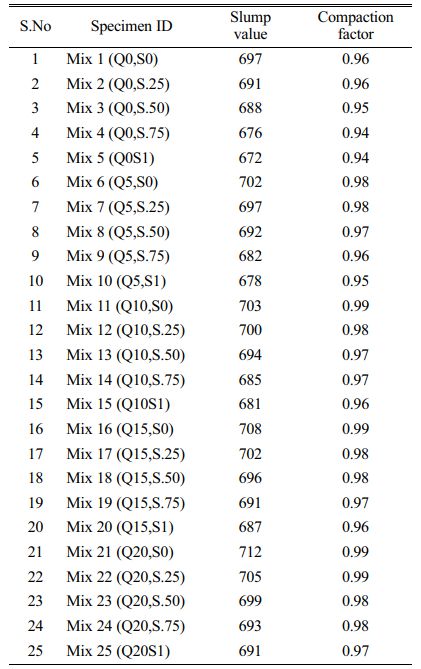
Fresh properties of mixes
The effects of hooked-end steel fiber in different ratios with the replacement of M sand by quartz (Mix 1(Q0, S0)- to Mix 25 (Q20S1) are listed in Tables 1 and 2. Due to the addition of fibers with M sand reduced the slump value and it overcame by the addition of 2.1% of SP with 0.11% of viscosity modifying agent. Replacement of quartz gives more workability than conventional and maximum slump value obtained from 20% quartz used mix. But the increase in the replacement of M sand the quartz by 20% leads to reduce the strength of the concrete.
The workability of concrete mixes with slump values and the compaction factors are presented in Table 3 (Mix 1(Q0, S0)- to Mix 25 (Q20S1) and Figs. 1 and 2. It shows the effect of the addition of Quartz and fibers in self-compaction concretes. The addition of quartz and fibers in self-compaction led to an increase the tensile and compressive strength.
In addition, the following material is commonly taken for all the mixing samples Cement 288 kg GGBS 124 kg Water Coarse Aggregate 1530 kg, and Water 144lt.
Compressive strength of concrete before the elevated temperature
The compressive strength of different mixes concerning steel fiber with a modification made in replacement of fine aggregate from M sand to Quartz is tabulated in Table 4 (Mix 1(Q0, S0)- to Mix 25 (Q20S1) and graphically represented by Fig. 3 from the recorded values.
Based on the observations it is identified that the samples Mix3, Mix8, Mix13, Mix18, and Mix23 which have 0.5% steel give more compressive strength compared to other mixing ratios of fiber. Similarly observed that Mix16, Mix17, Mix18, Mix19, and Mix20 had compressive strength higher than the other samples. It indicates the quartz replacement of 15% gives higher strength compared to other samples. By observing from Fig. 3. The optimum percentage of 0.5% of steel fiber and 15% quartz replacement indicates higher strength was tested before and after elevated temperature.
The compressive strength before elevated temperature for Mix1 is 60.20 N/mm2 whereas Mix18 is 65.84 N/mm2 and found that 9.0% strength increased due to 15% quartz and 0.5% steel fiber. Also found that the compressive strength after the elevated temperature is 41.18 N/mm2 and reduces its strength to 31.0% due to the higher forcible ejection of material in conventional concrete for the sample Mix18 the strength after the elevated temperature is 58 N/mm2 here the loss of strength reduced by 11.0%.
So it was observed that the influence of 15% quartz influenced this reduction from 30% to 11%. Further increasing the quartz from 15% to 20% the strength became reduced due to lack of binding property.
Effect of Split Tensile strength before and after elevated temperature
An experimental investigation of split tensile strength on the cylinder was conducted before and after the elevated temperature at 400 oC. The Split tensile strength before and after elevated temperature are presented in Table 5 (Mix 1(Q0, S0)- to Mix 25 (Q20S1). For conventional cylinder Mix1, the split tensile strength was noted that 5.06 N/mm2 and 4.14 N/mm2 before being placed into elevated temperature and after elevated temperature respectively. Similarly among all the samples, the maximum tensile strength observed in sample Mix 18 was 5.91 N/mm2 and 5.41 N/mm2 before and after elevated temperature respectively as shown in Fig. 4. The efficiency of Mix 18 was observed that 16% increased concerning conventional concrete placed before elevated temperature. In the same way, the values observed after elevated temperature as 30% increased. The reduction of split tensile strength for the control mix before and after the elevated temperature was 18% whereas only 8% was found in the optimum sample Mix 18.
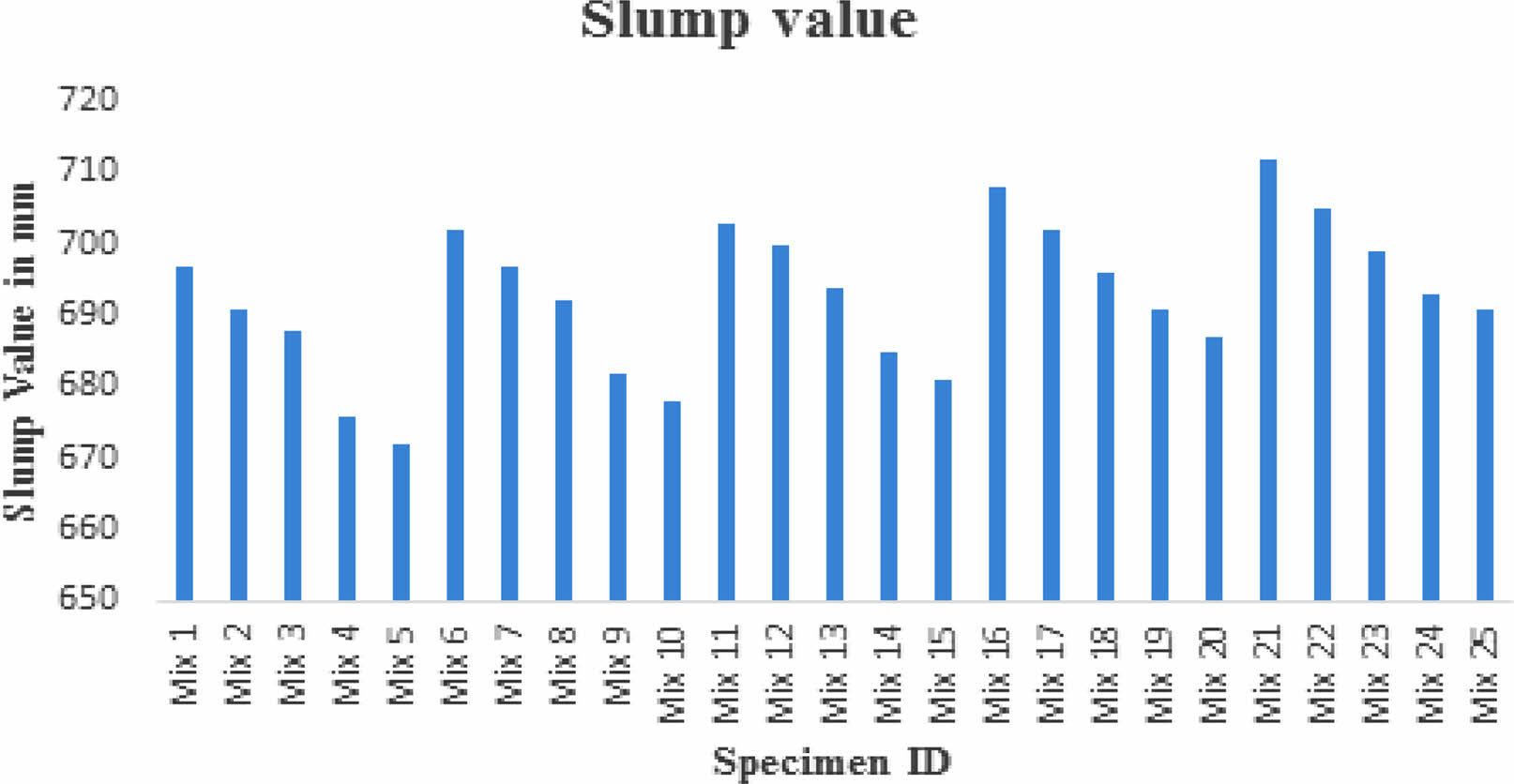
|
Fig. 1 Slump value of fresh concrete using Quartz and hookedend steel fiber |
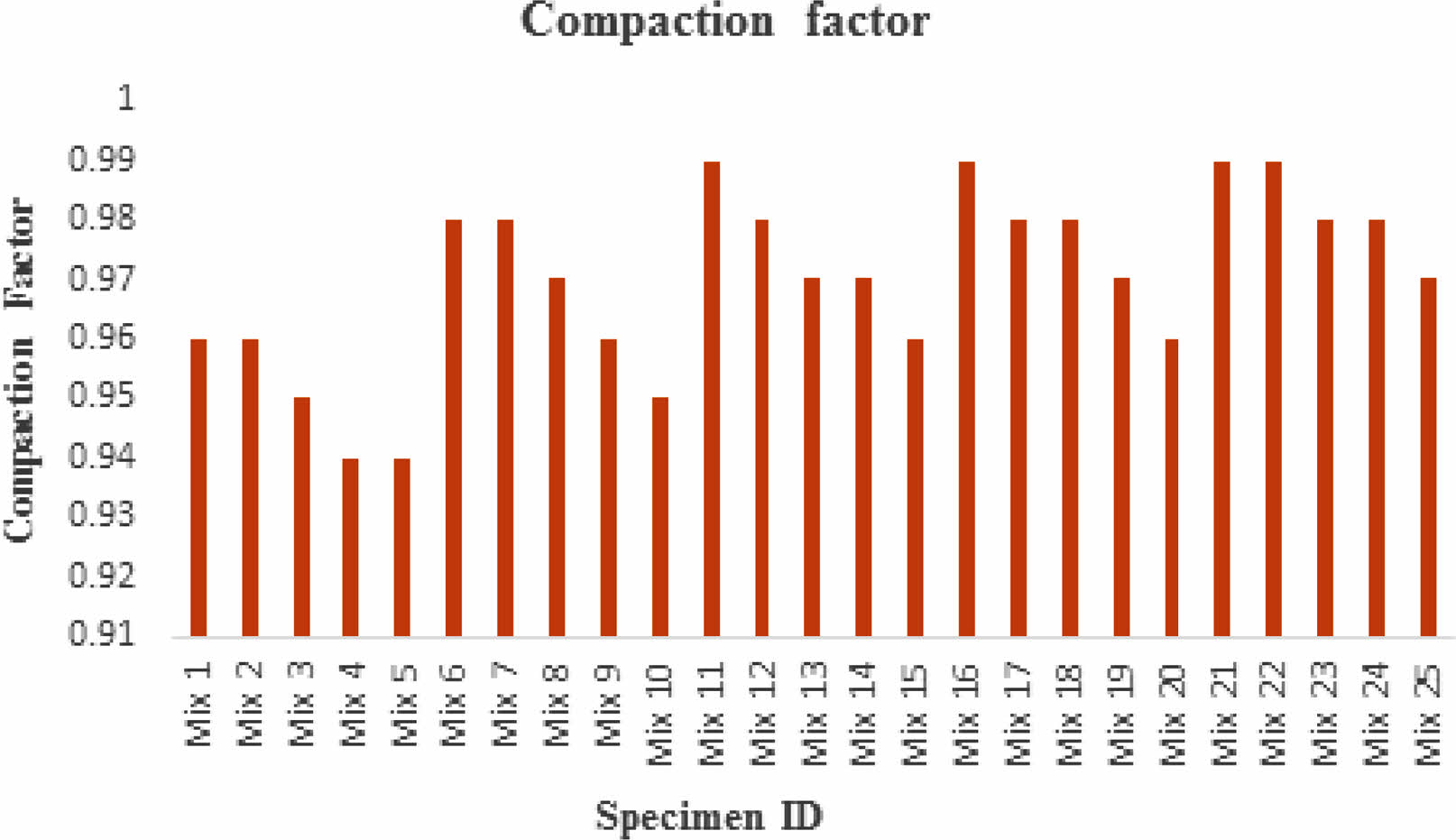
|
Fig. 2 Compaction factor of fresh concrete using Quartz and hooked-end steel fiber. |
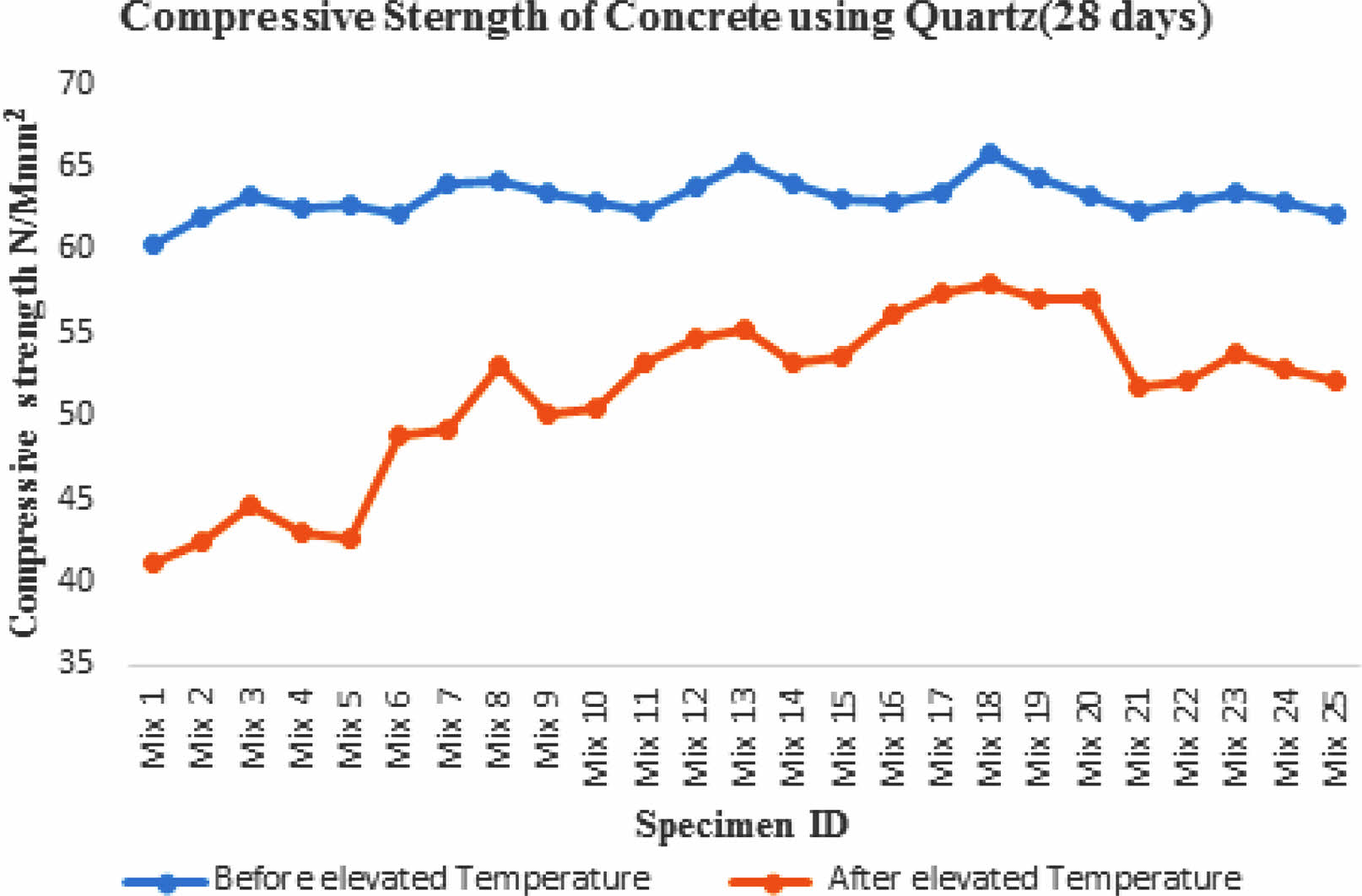
|
Fig. 3 Compressive strength of concrete specimens using Quartz and hooked end steel fiber. |
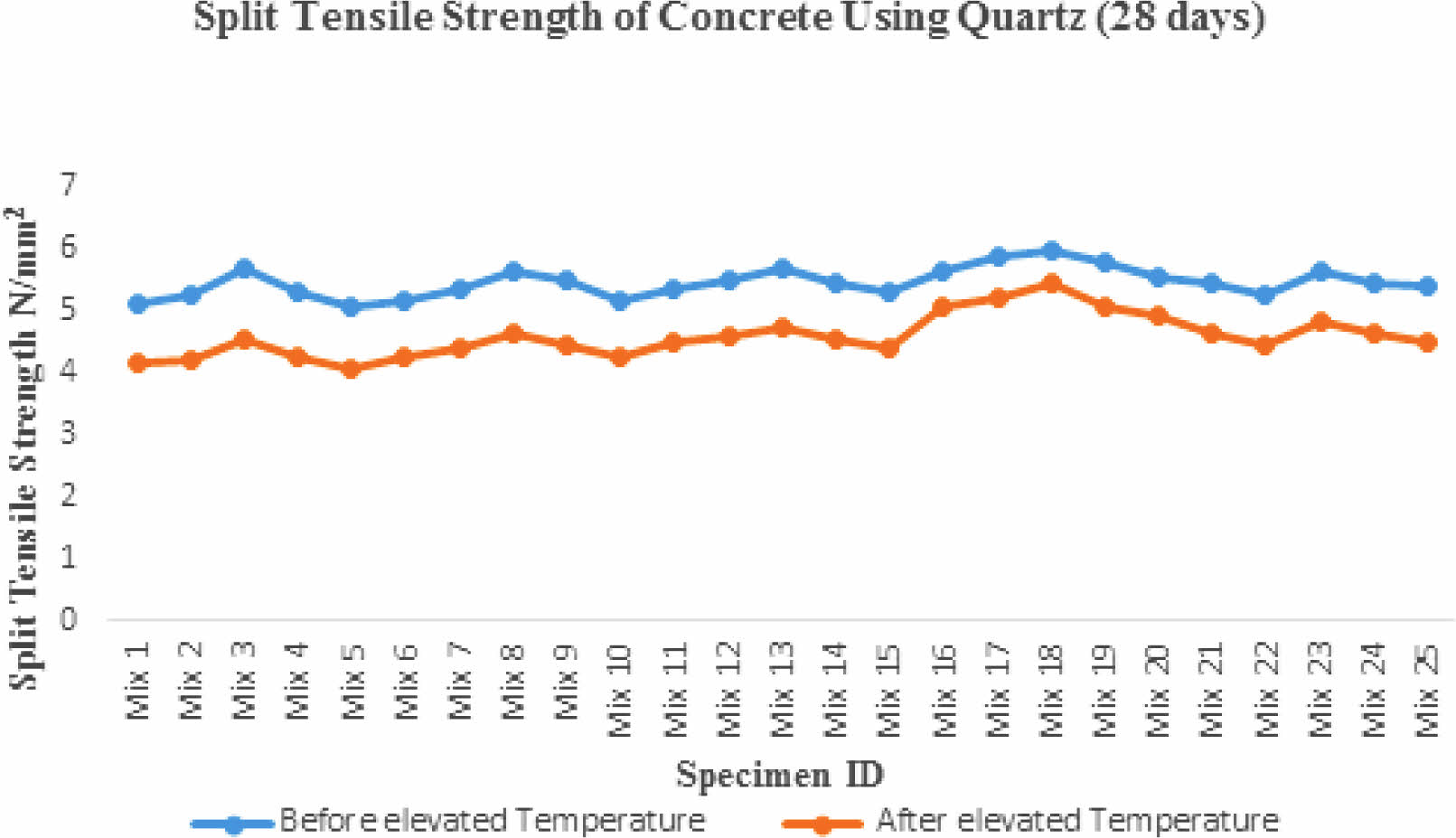
|
Fig. 4 Tensile strength of concrete specimens using Quartz and hooked-end steel fiber. |
|
Table 4 Compressive strength of concrete before and after elevated temperature. |
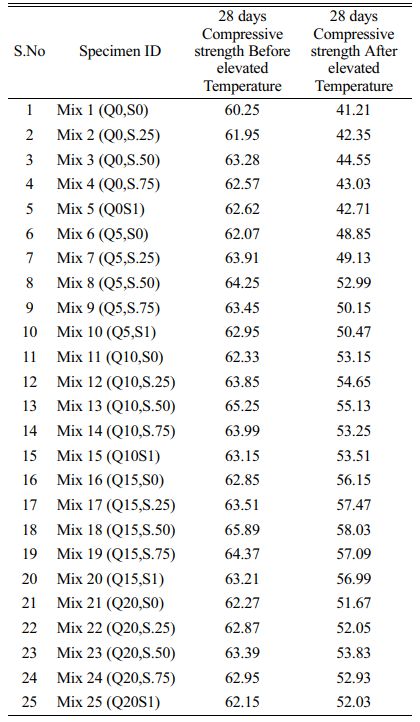
In this research work, quartz is used as 0%, 5%, 10%, 15%, and 20% replacement of river sand and also added constant proportion of 0.5% of hooked end steel fiber by weight of cement. We have performed many practicals and got good results. The compressive and split tensile strengths were better than the conventional concrete confirmed by the experimental results before and after the elevated temperature test. We found the maximum Compressive and split tensile with 15% replacement of river sand with Quartz sand and perform well in mechanical properties before and after being placed at 400 oC than the conventional concrete. From the results obtained above it is evident that the alternative natural sand with quartz at 15 percentages is optimum and produces good results. Eventually, this leads to better workability and durability of concrete.
No participation of humans takes place in this implementation process
No violation of Human and Animal Rights is involved.
No funding is involved in this work.
Conflict of Interest is not applicable in this work.
There is no authorship contribution
There is no acknowledgment involved in this work.
- 1. K. Ganesh Babu, and V. Sree Rama Kumar, Cem. and Conc. Rese. 30[7] (2000) 1031-1036.
-

- 2. M.R. Antonyamaladhas, S. Chachithanantham, and A. Ramaswamy, Adv. in Mater. Sci. and Eng. 2016 (2016) 1-9.
-

- 3. R.A. Hawileh, J.A. Abdalla, F. Fardmanesh, P. Shahsana, and A. Khalili, Archi. of Civ. and Mech. Eng. 17[3] (2017) 511-519.
-

- 4. S. Nagajothi, and S. Elavenil, Silicon. 13 (2021) 507-516.
-

- 5. S.I. Hong, and K.Y. Ann, Adv. in Mat. Sci. and Eng. 04 (2017) 1-10.
-

- 6. S. Kumar, R. Chandra Gupta, and S. Shrivastava, J. of Cleaner Prod. 140[3] (2017) 1129-1135.
-

- 7. M. Abdelrahim, A. Elthakeb, M. Usama, and M. Noaman, Civ. and Envi. Eng. 17[1] (2021) 270-276.
-

- 8. D. Chen, M. Deng, C. Hao, X. Lan, and L. Mo, J. of Wuhan Uni. of Tech. Mater. Sci. 32 (2017) 1140-1146.
-

- 9. J. Krishna Bhanu, J. Durga Chaitanya Kumar, and A. Eluru, Materi. Today: Procee. 27[2] (2020) 1099-1103.
-

- 10. M. Lenin Sundar, and P. Mithuna, Inter. Resea. J. of Eng. and Tech. 07[09] (2020) 1075-1080.
- 11. Q. Yanga, S. Zhanga, S. Huanga, and Y. Heb, Cem. and Concr. Rese. 30[12] (2020) 1993-1998.
-

- 12. A. Caggiano, S. Gambarelli, E. Martinelli, and N. Nisticò, Cons. and Buil. Mater. 125 (2016) 1035-1043.
-

- 13. N. Ranjbar, and M.Z. Zhang, Cem. and Conc. Compos. 107 (2020) 103498.
-

- 14. N. Ganesan, P.V. Indira, and M.V. Sabeena, Materi. & Des. 54 (2014) 686-693.
-

- 15. G.A. Chithambar, and M. Muthukannan, J. of Materi. and Eng. Struct. 6[04] (2019) 501-512.
- 16. Q.U.Z. Khan, Iran J. Sci. Tech. Trans. Civ. Eng. 46 (2022) 3627-3642.
-

- 17. G.J. Parra-Montesinos, ACI Struct. J. 102[5] (2005) 668-675.
-

- 18. B. Jeyaprabha, G. Elangovan, and P. Prakash, Const. and Build. Materi. 114 (2016) 688-698.
-

- 19. J.W. Luo, and F.J. Vecchio, ACI Struct. J. 113[01] (2016) 75-84.
-

 This Article
This Article
-
2023; 24(3): 554-559
Published on Jun 30, 2023
- 10.36410/jcpr.2023.24.3.554
- Received on Mar 8, 2023
- Revised on Apr 20, 2023
- Accepted on May 17, 2023
 Services
Services
- Abstract
introduction
materials and methods
testing methods
result and conclusion
conclusions
- Ethics Approval and Consent to Participate
- Human and Animal Rights
- Funding
- Conflict of Interest
- Author Contributions
- Acknowledgements
- References
- Full Text PDF
Shared
 Correspondence to
Correspondence to
- V. Thamilpriya
-
Teaching Fellow,Department of Civil Engineering, University College of Engineering, Pattukkottai, Tamil Nadu, 614701, India
Tel : +91918489966887 - E-mail: thamilpriya0711@gmail.com






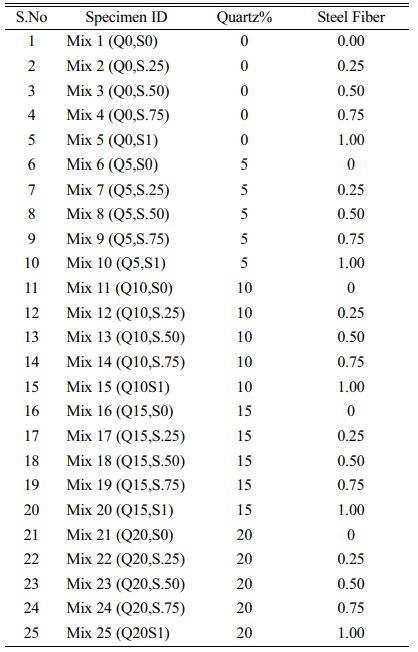
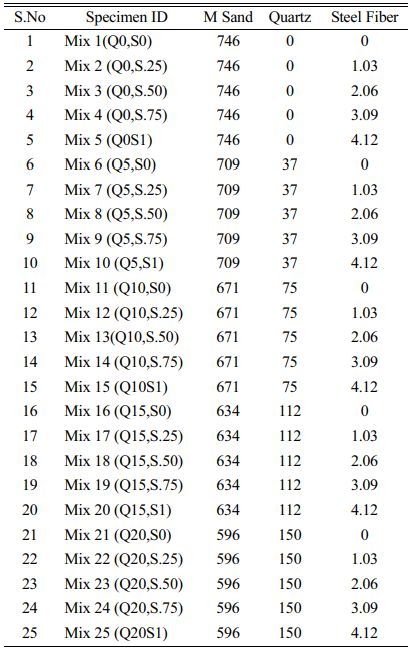
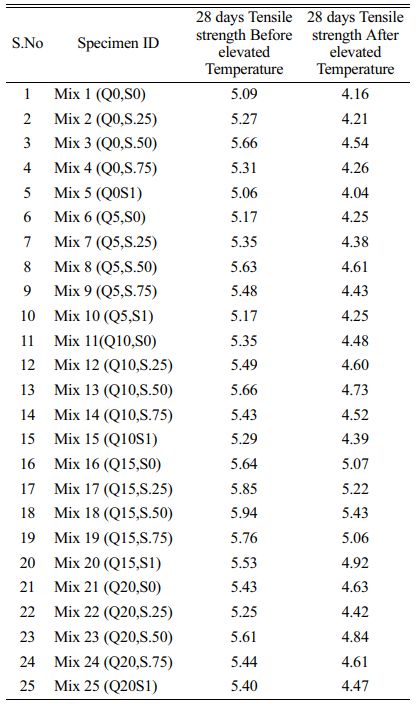
 Copyright 2019 International Orgranization for Ceramic Processing. All rights reserved.
Copyright 2019 International Orgranization for Ceramic Processing. All rights reserved.